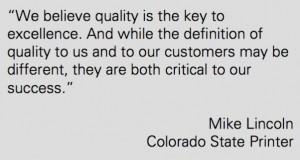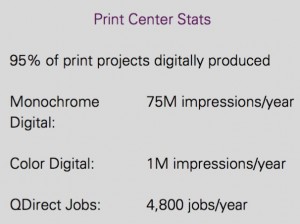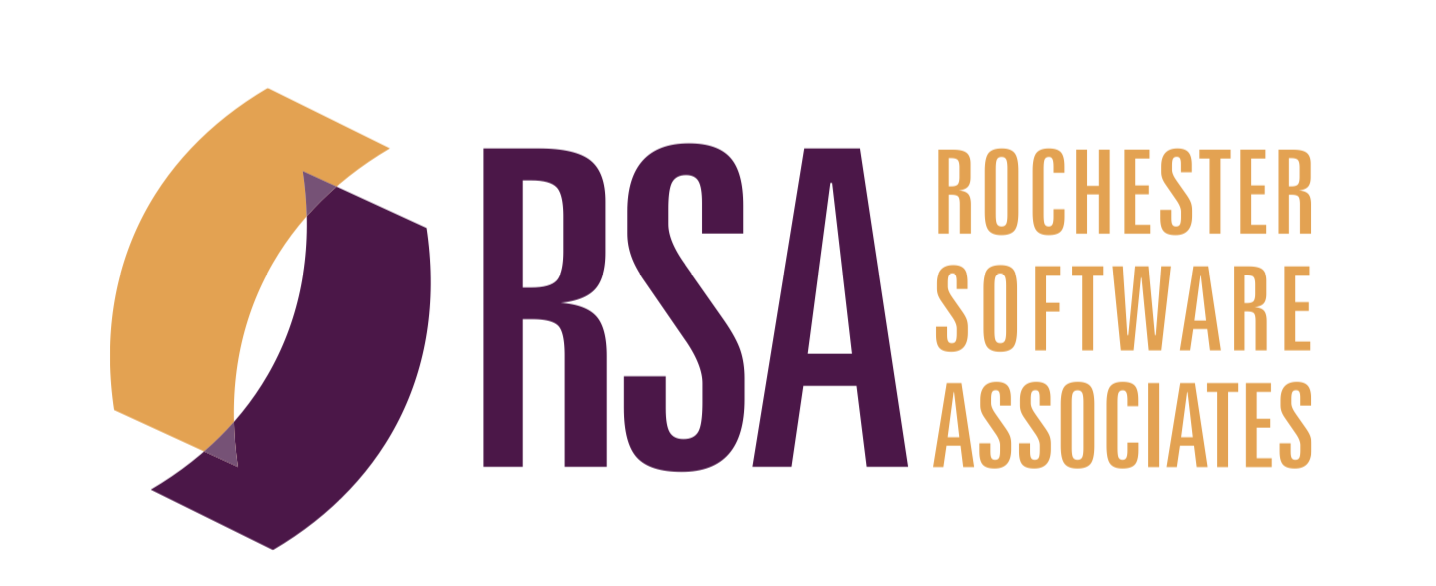Customer Background/Solution Overview
The State of Colorado operates four independent print operations across the state. The main print operation is under the Department of Personnel and Administration’s Division of Central Services (DCS), with 60 employees and an annual budget of more than $15 Million, they are the fourth largest government in-plant in the country.
“Our four shops each have their own niche in terms of what we produce,” explains Mike Lincoln, Colorado State Printer. “Integrated Document Solutions (IDS) in Denver focuses more on variable data, transactional and trans- promotional printing. DCS is statutorily charged with oversight in all state matters related to printing.
The other three operations are located at the Department of Transportation and the Department of Health; those shops do more traditional in-plant work, including brochures, booklets, handouts and reports.
The fourth is the Department of Corrections which has very specific responsibilities. They run a vocational program where offenders can learn valuable print shop skills while primarily producing forms on a half-sheet, color web press.”
For easy access to product information, sales presentations, cases studies, vertical messaging and more, sign up for an RSA partner resource portal account.
To stay continually abreast of RSA and in-plant news, tips, and content, subscribe to our newsletters.
 The state has had an ongoing relationship with RSA since 1999. They began by using M.I.S. PrintTM for transforming legacy LCDS data from the state’s mainframes for printing on production printers. Quality is important, particularly in the government sector, and the State of Colorado holds everyone to a high standard. With M.I.S. Print 100% document fidelity is guaranteed.
The state has had an ongoing relationship with RSA since 1999. They began by using M.I.S. PrintTM for transforming legacy LCDS data from the state’s mainframes for printing on production printers. Quality is important, particularly in the government sector, and the State of Colorado holds everyone to a high standard. With M.I.S. Print 100% document fidelity is guaranteed.
In 2003, RSA developed a custom application to name files coming from the Colorado Benefits Management System (CBMS) and normalize the print stream for output in the print shop.
Finally, in 2008, IDS installed RSA’s output management software, QDirectTM, to manage output, route jobs and maximize utilization of all their production equipment.
With jobs coming in from “everywhere, all the time,” QDirect was needed.
“Jobs come into IDS from everywhere across the state,” says Lincoln. “We still get M.I.S. Print jobs from the mainframe. There are four applications coming into our MSFTP server. We have regular print streams controlled by customer service that send files to QDirect including PowerPoint presentations, reports and internal communications that need to be printed. And we still use the custom application that RSA developed to bring in information from Colorado Benefits Management System (CBMS).”
In fact, CBMS files are 60% of the total work going through the RSA custom application and QDirect. CBMS is responsible for providing monthly statements to people served by the state. These are all the public facing documents generated by social programs for the state, everything from Medicaid and Medicare to foster families, WIC, food stamps and more. IDS receives three to four batch files a day, 365 days a year, from Deloitte who manages the system for CBMS.

Automation is one of the keys to increasing efficiency for Colorado.
 Before they used QDirect, IDS had to manually check their MSFTP server constantly to see if one of their five customers who use the system had uploaded files. Now QDirect queries the server automatically and grabs jobs as soon as they arrive. This increases efficiency, reduces touches and of course, saves time producing those jobs. QDirect has also improved load balancing. “Prior to QDirect we were managing queues with hot folders,” explains Lincoln. “It was clunky. It was difficult to move jobs from one machine to the next if a machine went down or a priority for a job changed and we had to move the job to another queue. QDirect makes balancing incredibly easy.”
Before they used QDirect, IDS had to manually check their MSFTP server constantly to see if one of their five customers who use the system had uploaded files. Now QDirect queries the server automatically and grabs jobs as soon as they arrive. This increases efficiency, reduces touches and of course, saves time producing those jobs. QDirect has also improved load balancing. “Prior to QDirect we were managing queues with hot folders,” explains Lincoln. “It was clunky. It was difficult to move jobs from one machine to the next if a machine went down or a priority for a job changed and we had to move the job to another queue. QDirect makes balancing incredibly easy.”
When Colorado Needed an Encryption Solution, RSA Secured It. One of IDS’ customers had a new income tax job for them to print. IDS completed the entire project planning on the front end of the job, but one day before implementation the customer informed them that all of the data needed to be encrypted before it could be sent. The job was stalled while IDS contacted internal Information Technology resources. Colorado’s IT understood what was needed but didn’t have the time or the resources to tackle the job. IDS turned to RSA. Within two and a half weeks RSA installed the solution to enable the secure transmission of print data to the print center.
 “Since QDirect was already being used to manage the job, RSA was the obvious choice to help with encryption,” said IDS Project Manager, Mike Sexson. “Having a partner in technology that really supports and understands what our wants and needs are is really important,” added Mike Lincoln.
“Since QDirect was already being used to manage the job, RSA was the obvious choice to help with encryption,” said IDS Project Manager, Mike Sexson. “Having a partner in technology that really supports and understands what our wants and needs are is really important,” added Mike Lincoln.
Putting a Plan in Place for the Future
IDS has an overall strategic objective to be a service bureau provider to the public sector of the State of Colorado. They are well on their way. A next step will be replacing their current monochrome printers with continuous-fed inkjet color solutions.
“The reason why IDS is going to continuous-fed, color inkjet is to be able to bring new capabilities to our state customers,” says Mike Lincoln. “Transactional printing is a growing category for the state and we want to leverage the transpromotional strategies being used more and more in commercial print shops to help state agencies get more value from every print job, too.” IDS is planning to show state agencies how they can share the cost of printing by sharing the real estate on the page. “One obvious opportunity is snowmobile, boat and off- road vehicle registration,” explains Lincoln. “Three times a year registration renewals must be sent out by the department of parks and wildlife. When we’re sending out a document that says boating season is coming up and it’s time to register your boat, why don’t we cross sell fishing licenses and let those two groups share the cost of the print. We could do the same for registration notices for off-road vehicles with similar license messaging for hunting.”

